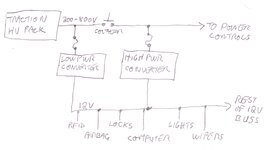VectorBear
Electrical
For standby (car powered down), why not have a low quiescent power traction voltage to 12V converter to power standby peripherals such as RFID key fob detector, security system, door locks, computer when the car initially powers up, etc. Once the car does power up, immediately the traction contactor closes and turns on the larger (100-200W?) converter to not only power all of the running 12V system but charge that 12V battery.
Usual arguments are silly: no isolation of traction voltages (converter can be before contactor, with its own protection), drain on traction pack (50-100kWh can handle a few W for a very long time), safety if traction pack fails (but what if 12V system fails in a collision? in the same boat), status quo AKA legacy (time for a new status quo).
So why not replace the 12V battery with a low power, low quiescent power traction voltage to 12V converter to run standby systems?
Usual arguments are silly: no isolation of traction voltages (converter can be before contactor, with its own protection), drain on traction pack (50-100kWh can handle a few W for a very long time), safety if traction pack fails (but what if 12V system fails in a collision? in the same boat), status quo AKA legacy (time for a new status quo).
So why not replace the 12V battery with a low power, low quiescent power traction voltage to 12V converter to run standby systems?

